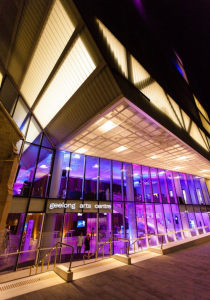In 2022, Geelong Arts Centre partnered with Culture Counts to build an audience development strategy to help engage and grow its audiences.
Culture Counts collaborated with independent consultant, Merryn Carter, to manage and deliver the project, ultimately delivering a comprehensive report and strategy alongside a custom segmentation model for the venue.
Geelong Arts Centre is one of the largest arts centres in Victoria. The multi-venue space sees over 200,000 visitors every year across a diverse program of events and performances. This research coincides with a period of immense change at the Centre, which has undergone a significant redevelopment thanks to a $140 million investment from the Victorian government.
The Centre attracts popular productions and seeks to meet the increasing demands for arts and cultural activity in the area, while simultaneously trying to keep their ‘small art centre’ culture that is friendly, accessible and hyper-local.
The audience development strategy centred around how the new and growing arts centre could foster and develop its relationship with its current audience, while also expanding its engagement with the fast-growing communities of Geelong and wider Victoria.
“Audience development is that relationship with who we are, being authentic, being genuine and building relationships with our audiences, rather than being transactional.”Joel McGuinness, CEO, Geelong Arts Centre Visit the website
Requirements
The Centre provided a clearly defined brief for the scope of work and their expectations for its utilisation within the organisation. Geelong Arts Centre required an audience development plan that could:
- Represent a strategic pathway for growth, ensuring alignment with its goals and vision.
- Maintain relevance, sustain financial health, and strengthen community connections.
- Assist with resource allocation, focus on retaining existing audiences and adapt to changing trends.
- Utilise measurable outcomes and data-driven insights to support its curation of engaging experiences and informed decisions.
Approach
Culture Counts identified five key data sources essential for developing the strategy:
- Audience Sentiment and Behaviour
- Ticketing Activity (from 2019 to 2022)
- Donor Sentiment
- Venue Hirer Sentiment
- Non-Visitor Sentiment and Behaviour (i.e. local community)
The wide-reaching datasets required posed methodological challenges, particularly when it came to collecting information about non-visitors. Surveys were distributed to respondents via several channels including QR codes and digital online surveys, ensuring they reached the breadth of the sample. Intercept surveys also took place over several days in the Geelong town centre, to capture feedback and attitudes from non-visitors.
All survey data sought to measure the attitudes and motivations of audiences, their behaviour and their opinions of Geelong Arts Centre.
Key Findings
Between 2019 – 2022, Geelong Arts Centre saw:
- 69,906 tickets sold
- 22,983 bookings taken
- 19% of customers purchased 70% of all tickets sold
The evaluation of the Centre’s audience revealed various insights. We’ve highlighted key findings below.
Commercial productions represent the majority of the total box office.
Three years of ticket data revealed that Commercial productions made up the majority of box office tickets, representing 54%. Programmed shows made up 20% of total tickets sold, while Community and Classical productions represented 13% each.
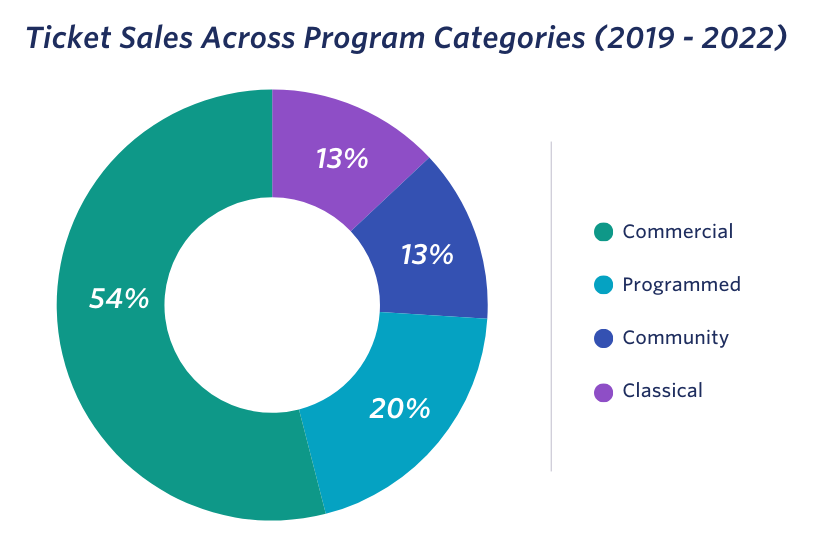
For research purposes, the Centre’s program was divided into four categories:
- Commercial: Shows where an organisation hires the venue.
- Programmed: Events booked/programmed by Geelong Arts Centre.
- Community: Shows supported by the Centre, promoting local artists and community groups.
- Classical: Performances of classical music. Split out due to unique audience buying patterns and the Centre’s management of the concert hall venue, Costa Hall.
Each of these categories consisted of various events and genres, including theatre, dance, circus, and contemporary music.
Regular ticket buyers represent the most significant proportion of total box office.
Ticket buyers were classified into three categories based on the number of ticket transactions; single-ticket buyers (1 – 2), occasional (3 – 5) and regulars (6+). Although ‘Regular’ bookers only represented 6% of the database, they represented 47% of total box office sales.
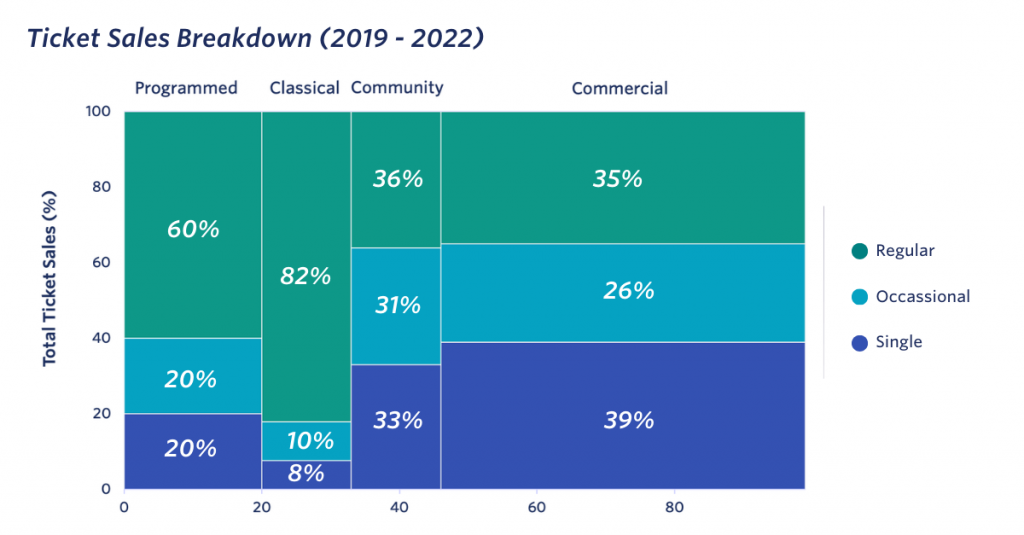
When reviewing the breakdown of ticket buyer types by program, classical music attendees were the most likely to be regular ticket buyers – 82% were ‘regular’ attendees. This was in contrast to commercial productions, where only 35% of ticket buyers were ‘regular’ attendees, while 39% were ‘single’ attendees.
So, whilst Commercial productions sold more tickets than Classical shows, the latter boasted greater customer loyalty.
Regular ticket buyers are interested in a variety of programming.
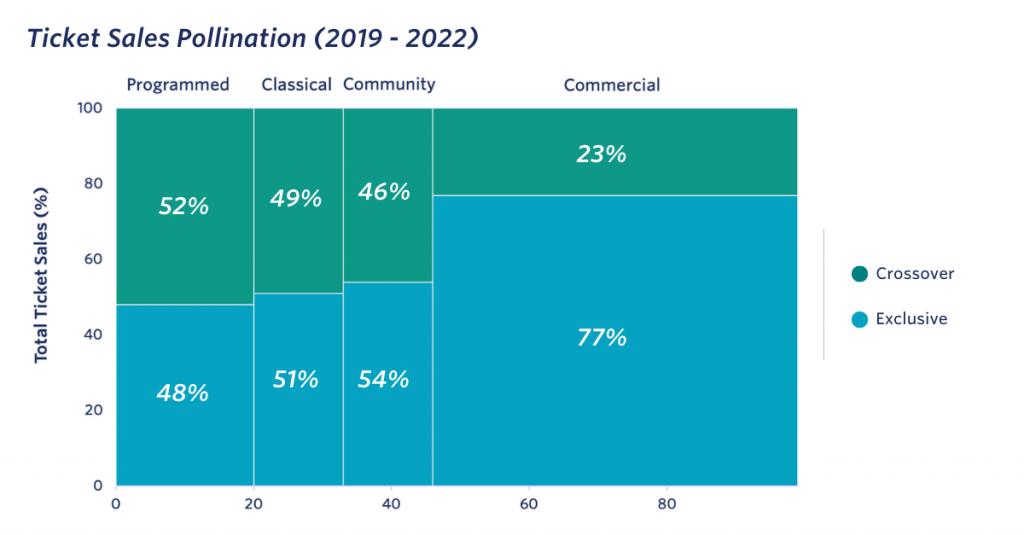
There is a belief that audiences ‘stay in their lane’ when it comes to purchasing behaviour. Data analysis revealed that this is not always the case. When reviewing ‘pollination’ of ticket buyers, Culture Counts discovered that for ‘programmed’, ‘classical’ or ‘community’ productions, almost half of those ticket buyers also purchased tickets to a production in another category.
This was in complete contrast to ticket buyers for commercial productions, who were much more likely to only ever purchase tickets for those productions (77%). This serves as an important segmentation identifier for all production types, whether they are community programs, theatre or classical music – a significant proportion of performing arts audiences like to see performing arts.
It’s important to create custom segments that resonate with your organisation.
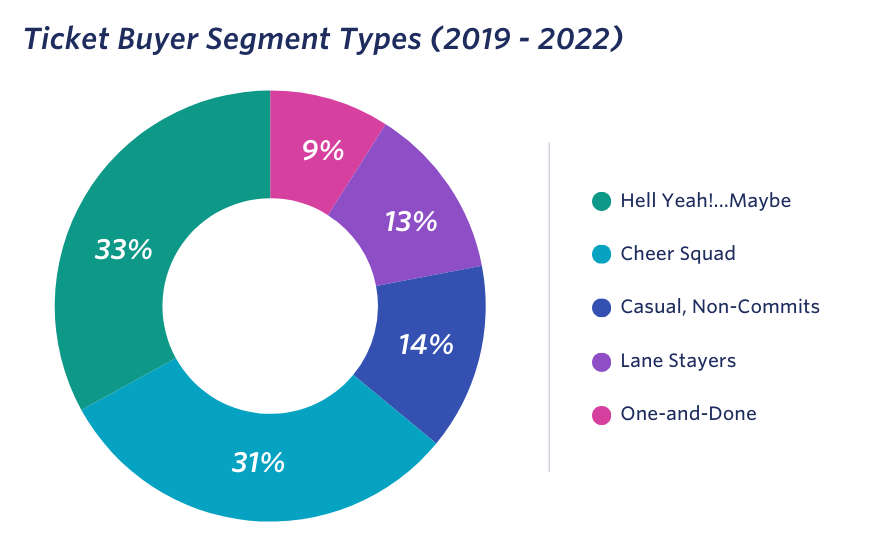
The categorisation model applied by Culture Counts provided a more suitable lens for analysis. We suggested three key factors with which to segment the Geelong Arts Centre Audience; buyer type (i.e. ‘Regular’, ‘Occasional’, ‘Singles’), openness to new experiences and cultural activity frequency.
This approach creates 12 audience segments. To make the segments more practical for the Geelong Arts Centre team, these are married together to create 5 statistically distinguishable groups. We then worked with the Geelong team to explore these segments and give them names that resonated with the staff. During a staff workshop, we explored each segment type, ultimately naming them the following: ‘Cheer Squad’, ‘Lane Stayers’, ‘One and Done’, ‘Casual, Non-Commits’ and ‘Hell Yeah!…Maybe’.
‘Hell Yeah!…Maybe’ (33%) and ‘Cheer Squad’ (31%) were the largest booking segments, with the other three groups being similarly sized. When thinking about where to focus attention on building new regular audiences, the ‘Hell Yeah!…Maybe’ segment (46% of the database) had the greatest potential to start developing first.
Outcome
Joel McGuinness (Geelong Arts Centre), Jordan Gibbs (Culture Counts) and Merryn Carter presented a case study of the project at the 2023 Australia Performing Arts Exchange. Reflecting on the results of the project, the team highlighted the importance of staff engagement and cultivating shared enthusiasm in workshops.
- “This research showed me that, for us, the subscription season is not dead…but how do we get those subscribers to come to new work? They trust us!” – Joel McGuinness
- “Ultimately, the combination of learning and enjoyment in these [staff] workshops fosters a positive atmosphere that aligns teams with the broader mission of audience development, and encourages a collective commitment to its success” – Jordan Gibbs
- “I would love to dive deeper into those ‘Hell!…Yeah Maybes’. Overcome their barriers and… lean in to the things that get them going” – Merryn Carter
The research assisted Geelong Arts Centre in better understanding and communicating with its audiences. It emphasised the need to embed an audience development plan into daily operations, to conduct regular reviews and to ensure any audience development plan remains adaptable.
Culture Counts thanks Merryn Carter and the Geelong Arts Centre team for their invaluable contributions to the project. If you would like to enquire with Culture Counts regarding your own bespoke consulting project, you can contact us here.


